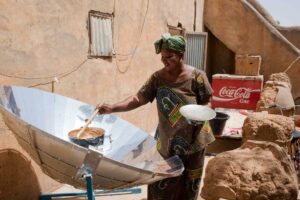A team of rivals is making the denim industry more sustainable. NBS research guides the collaboration.
The global denim industry is criticized for water waste, polluting processes, and labor violations. For example, in Xingtang, China, the “blue jeans capital of the world,” the local river runs denim black from dyes and other chemicals.
A possible solution to the industry’s challenges: competitor collaboration. When an issue — like pollution or worker safety — matters to an entire industry, it can make sense for competitors to come together to find answers.
Competitor collaborations bring cutthroat rivals together to share ideas and find solutions. And the results can be amazing: new technologies, shared standards, effective government policies.
But these collaborations aren’t easy, as rivals try to become a team.
Denim industry leaders in Amsterdam have taken this high-risk, high-rewards approach, founding the Alliance for Responsible Denim (ARD). They’re building on pioneering NBS research on competitor collaboration, developed by Dr. Lori DiVito (Amsterdam University of Applied Sciences).
DiVito is directly involved in ARD. She is sharing her knowledge and working with managers to shape ARD’s structure and agenda.
Dutch Leadership on Denim
Amsterdam is an internationally renowned centre of denim expertise. It’s a place where international denim brands have design centres, international denim suppliers and mills have local offices, and young brands begin. It’s also the hub for sustainability innovation in the denim industry.
ARD brings together denim brands and suppliers with industry experts and stakeholders. Together, they focus on (1) increasing the use of post-consumer recycled denim and (2) establishing measurements, benchmarks and standards for use of resources such as chemicals, water, and energy.
A Team of Rivals
It can be hard for companies used to fighting tooth and nail to work together effectively. Research shows that 90 per cent of executives recognize the importance of sustainability collaboration in general, but only 47 per cent actively collaborate. Involvement in competitor collaboration is significantly rarer.
Here’s what companies in ARD have learned about working together.
Challenges are real.
Having different types of members in the collaboration increases impact, but causes tensions. James Veenhoff of the House of Denim, a denim industry think tank and ARD member, praises that diversity. “It’s unique that we have big and small denim brands together with suppliers working on these sustainability issues,” he says. “It’s the only way to progress and change the industry.” But companies come at the topic from different positions, and not everybody wants the same thing. Companies have:
-
Different levels of knowledge: Some brands are sustainability leaders; others are still learning. Leaders often don’t want to share their secrets, such as a more sustainable finishing process that also gives the jeans a unique look. Learners can become passive, absorbing ideas rather than engaging in dialogue.
-
Different ambitions: Companies have different brand images. Some have made sustainability central to their positioning. Those companies want to push for higher impact goals, with larger percentages of recycled fibre or elimination of hazardous chemicals in finishing processes. Others take sustainability seriously but don’t want to emphasize it. They think that publicly talking about sustainability increases stakeholder expectations or makes customers see the brand as poorly designed and overpriced. Company size factors in as well, as larger brands have more power to change the look and feel of their products
People are busy. ARD requires each brand to attend a quarterly three-hour working group meeting. Brands also work with ARD coordinators between meetings to gather data such as production information from their suppliers and product specifications from the brand’s internal teams.
This level of engagement is not for the faint of heart. If the brands do not see value, and see it quickly, they are quick to disengage. “There are a lot of sustainability initiatives in the apparel industry,” DiVito explains, “so brands see a duplication and have to decide where to engage.”
Competition is everywhere. Competition hides on multiple levels in the value chain. Competing brands, competing suppliers, competing initiatives. All these can affect dynamics within the collaboration.
Keep team spirit alive.
To address these challenges and provide value, ARD has taken these strategies:
-
Communicate. Constant, frank communication is key. DiVito has a team member dedicated to communication with participating companies. Company staff can share concerns with him in one-on-one conversations. He also lightens their workload for ARD by collecting needed data in conversation with the companies or their suppliers.
-
Accept that no one can be forced to have fun at the party. Not every participating company will have the same level of engagement. Speaking about the brands that do not want to be publicly associated with sustainability, DiVito explains: “These brands acknowledge that there is no other solution but the sustainable one, so they are at the table. But they are not ready to openly communicate their commitment, and that’s okay.” She expects that involvement will gradually increase their interest.
-
Provide value along the way — and celebrate. Companies have committed to ARD for a minimum of two years. That short timeline makes it easier for companies to commit resources — but isn’t actually enough time to achieve the necessary transformation. To keep companies involved, DiVito works to have valuable takeaways from every meeting. These are intriguing discoveries like the impact of different denim finishing; and real products, like the development of a shared recycled denim fabric, or changes to production processes. “Meetings should show progress and provide learning,” says DiVito. ARD also celebrates each milestone. For example, all brands signed a pair of denim jeans at ARD’s kickoff (see below). Simple gestures go a long way in sustaining commitment.
-
Have a referee. The collaboration manager should be a trusted neutral party without commercial interests. That person can identify tensions between different interests and support dialogue to find common ground. Finding that that neutral person can be tricky. Relevant nonprofits may have commercial interests, either in direct revenue from the collaboration or in indirect revenue from follow-on consultancy.
Rivals are relevant.
A competitor collaboration is a bit like a meeting of sports heroes. There are tensions, but also a sense of being with peers that can be powerful and positive. Competitors rarely sit at the same table exchanging information and ideas. Yet as professionals in the same industry, they are aware of each other. Competitors want to benchmark themselves and compare their progress or behaviour.
Building on that interest and engagement can change the world.



Add a Comment
This site uses User Verification plugin to reduce spam. See how your comment data is processed.This site uses User Verification plugin to reduce spam. See how your comment data is processed.